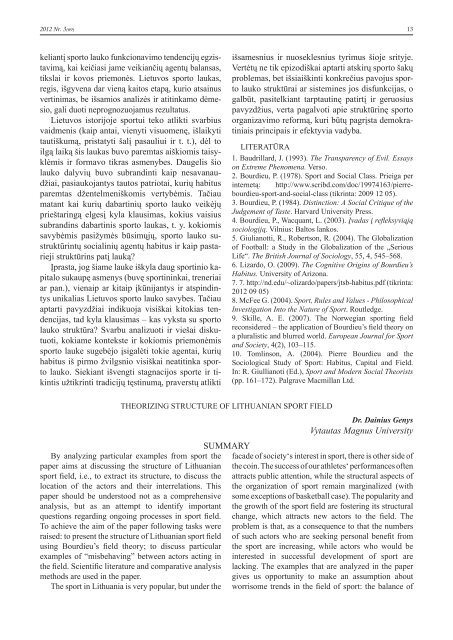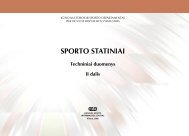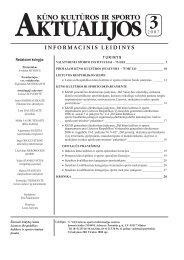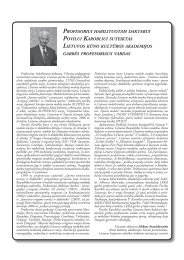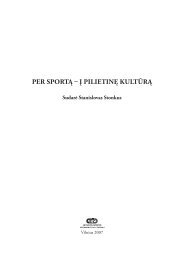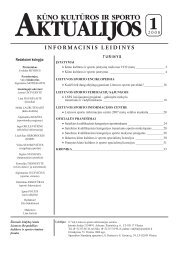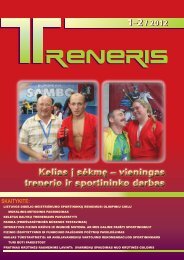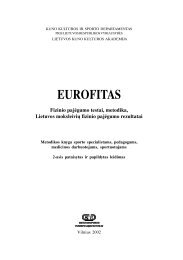Nr. 3 - Lietuvos sporto informacijos centras
Nr. 3 - Lietuvos sporto informacijos centras
Nr. 3 - Lietuvos sporto informacijos centras
You also want an ePaper? Increase the reach of your titles
YUMPU automatically turns print PDFs into web optimized ePapers that Google loves.
2012 <strong>Nr</strong>. 3(69)<br />
13<br />
keliantį <strong>sporto</strong> lauko funkcionavimo tendencijų egzistavimą,<br />
kai keičiasi jame veikiančių agentų balansas,<br />
tikslai ir kovos priemonės. <strong>Lietuvos</strong> <strong>sporto</strong> laukas,<br />
regis, išgyvena dar vieną kaitos etapą, kurio atsainus<br />
vertinimas, be išsamios analizės ir atitinkamo dėmesio,<br />
gali duoti neprognozuojamus rezultatus.<br />
<strong>Lietuvos</strong> istorijoje sportui teko atlikti svarbius<br />
vaidmenis (kaip antai, vienyti visuomenę, išlaikyti<br />
tautiškumą, pristatyti šalį pasauliui ir t. t.), dėl to<br />
ilgą laiką šis laukas buvo paremtas aiškiomis taisyklėmis<br />
ir formavo tikras asmenybes. Daugelis šio<br />
lauko dalyvių buvo subrandinti kaip nesavanaudžiai,<br />
pasiaukojantys tautos patriotai, kurių habitus<br />
paremtas džentelmeniškomis vertybėmis. Tačiau<br />
matant kai kurių dabartinių <strong>sporto</strong> lauko veikėjų<br />
prieštaringą elgesį kyla klausimas, kokius vaisius<br />
subrandins dabartinis <strong>sporto</strong> laukas, t. y. kokiomis<br />
savybėmis pasižymės būsimųjų, <strong>sporto</strong> lauko sustruktūrintų<br />
socialinių agentų habitus ir kaip pastarieji<br />
struktūrins patį lauką?<br />
Įprasta, jog šiame lauke iškyla daug sportinio kapitalo<br />
sukaupę asmenys (buvę sportininkai, treneriai<br />
ar pan.), vienaip ar kitaip įkūnijantys ir atspindintys<br />
unikalias <strong>Lietuvos</strong> <strong>sporto</strong> lauko savybes. Tačiau<br />
aptarti pavyzdžiai indikuoja visiškai kitokias tendencijas,<br />
tad kyla klausimas – kas vyksta su <strong>sporto</strong><br />
lauko struktūra? Svarbu analizuoti ir viešai diskutuoti,<br />
kokiame kontekste ir kokiomis priemonėmis<br />
<strong>sporto</strong> lauke sugebėjo įsigalėti tokie agentai, kurių<br />
habitus iš pirmo žvilgsnio visiškai neatitinka <strong>sporto</strong><br />
lauko. Siekiant išvengti stagnacijos sporte ir tikintis<br />
užtikrinti tradicijų tęstinumą, praverstų atlikti<br />
išsamesnius ir nuoseklesnius tyrimus šioje srityje.<br />
Vertėtų ne tik epizodiškai aptarti atskirų <strong>sporto</strong> šakų<br />
problemas, bet išsiaiškinti konkrečius pavojus <strong>sporto</strong><br />
lauko struktūrai ar sistemines jos disfunkcijas, o<br />
galbūt, pasitelkiant tarptautinę patirtį ir geruosius<br />
pavyzdžius, verta pagalvoti apie struktūrinę <strong>sporto</strong><br />
organizavimo reformą, kuri būtų pagrįsta demokratiniais<br />
principais ir efektyvia vadyba.<br />
Literatūra<br />
1. Baudrillard, J. (1993). The Transparency of Evil. Essays<br />
on Extreme Phenomena. Verso.<br />
2. Bourdieu, P. (1978). Sport and Social Class. Prieiga per<br />
internetą: http://www.scribd.com/doc/19974163/pierrebourdieu-sport-and-social-class<br />
(tikrinta: 2009 12 05).<br />
3. Bourdieu, P. (1984). Distinction: A Social Critique of the<br />
Judgement of Taste. Harvard University Press.<br />
4. Bourdieu, P., Wacquant, L. (2003). Įvadas į refleksyviąją<br />
sociologiją. Vilnius: Baltos lankos.<br />
5. Giulianotti, R., Robertson, R. (2004). The Globalization<br />
of Football: a Study in the Globalization of the „Serious<br />
Life“. The British Journal of Sociology, 55, 4, 545–568.<br />
6. Lizardo, O. (2009). The Cognitive Origins of Bourdieu’s<br />
Habitus. University of Arizona.<br />
7. 7. http://nd.edu/~olizardo/papers/jtsb-habitus.pdf (tikrinta:<br />
2012 09 05)<br />
8. McFee G. (2004). Sport, Rules and Values - Philosophical<br />
Investigation Into the Nature of Sport. Routledge.<br />
9. Skille, A. E. (2007). The Norwegian sporting field<br />
reconsidered – the application of Bourdieu’s field theory on<br />
a pluralistic and blurred world. European Journal for Sport<br />
and Society, 4(2), 103–115.<br />
10. Tomlinson, A. (2004). Pierre Bourdieu and the<br />
Sociological Study of Sport: Habitus, Capital and Field.<br />
In: R. Giullianoti (Ed.), Sport and Modern Social Theorists<br />
(pp. 161–172). Palgrave Macmillan Ltd.<br />
Theorizing structure of Lithuanian sport field<br />
By analyzing particular examples from sport the<br />
paper aims at discussing the structure of Lithuanian<br />
sport field, i.e., to extract its structure, to discuss the<br />
location of the actors and their interrelations. This<br />
paper should be understood not as a comprehensive<br />
analysis, but as an attempt to identify important<br />
questions regarding ongoing processes in sport field.<br />
To achieve the aim of the paper following tasks were<br />
raised: to present the structure of Lithuanian sport field<br />
using Bourdieu’s field theory; to discuss particular<br />
examples of “misbehaving” between actors acting in<br />
the field. Scientific literature and comparative analysis<br />
methods are used in the paper.<br />
The sport in Lithuania is very popular, but under the<br />
Summary<br />
Dr. Dainius Genys<br />
Vytautas Magnus University<br />
facade of society‘s interest in sport, there is other side of<br />
the coin. The success of our athletes‘ performances often<br />
attracts public attention, while the structural aspects of<br />
the organization of sport remain marginalized (with<br />
some exceptions of basketball case). The popularity and<br />
the growth of the sport field are fostering its structural<br />
change, which attracts new actors to the field. The<br />
problem is that, as a consequence to that the numbers<br />
of such actors who are seeking personal benefit from<br />
the sport are increasing, while actors who would be<br />
interested in successful development of sport are<br />
lacking. The examples that are analyzed in the paper<br />
gives us opportunity to make an assumption about<br />
worrisome trends in the field of sport: the balance of


